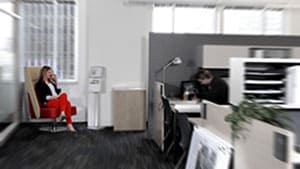New designs for lounge-style furniture can give employees a quieter space in more open offices to work or find some privacy.
Open offices have proved a beneficial strategy to improve collaboration and innovation and are unlikely to disappear. But the effectiveness of an open office is not absolute for every employee. Rather than designing to the lowest common denominator, tweaks in office furniture and design can turn any space into an employee’s comfort zone.
Noise distractions are one of the biggest drains on productivity in today’s open office. However, reducing office noise doesn’t have to mean quashing the creative open-office vibe by throwing up walls and separating people.
The furniture manufacturers who first invented the open office – creating a new world order for both introverts and extroverts – have responded to the noise issue with a variety of furniture solutions. Keilhauer Talk and BuzziHub offer semi-private lounge groupings without the cost of building hard walls.
Want to work alone? Vitra’s Workbay is like an old-fashioned study carrel made from thick polyester fleece. And although it may look like the hair-dryer chair your grandmother used at her salon, the privacy of the Massaud Lounge with canopy is worth the retro look. The canopy’s design helps reduce visual and audible distractions, and it comes with LED lighting and can even host mobile devices.
What happens in the open office when you need to make that private phone call? There are several stand-up phone booth options like Era’s Nautilus. This freestanding unit with striking, large horizontal stripes can be easily placed anywhere.
OFS makes a more architectural statement with its Jux Group Refuge. This giant wooden box creates a private enclave with different options for individual or collaborative work.Offecct makes several acoustical products, including sound absorbent wall panels in a variety of patterns and colors (even hot pink). They can be mounted directly to a wall to make bold visual patterns and textures, and there’s even a wall planter insert. Or try hanging acoustical baffles such as Sound Silencer or thick industrial felt panels from the ceiling to create a sculptural element.
Want to reduce noise and divide a room? BuzziBlind looks like giant freestanding vertical blinds, and Offecct makes a couple simple freestanding screens like Soundwaver.
While most of these strategies concentrate on sound-attenuation and individualized space, on the other end of spectrum is music. Believe it or not, allowing employees to be the DJ through overhead music sound systems helps establish a company culture. Sure, people may not like every song that is played, but creating an eclectic and employee-driven playlist establishes an energy that can build camaraderie and drive productivity. It can also break the deafening silence that more sterile spaces produce.
Try setting some general music category suggestions, like classical or acoustic in the morning and mid-tempo music in the afternoon — then let them loose after 4 p.m.
Admittedly, not every office will have the personality to pull off some of these ideas. If not, managers can still bring some control to the open space by investing in good sound-masking technology.
Also called white noise, sound masking is actually quite effective at reducing ambient noise by emitting a sound spectrum that covers noise over 15-20 feet away. Unlike noise produced by mechanical systems that produce an uneven sound spectrum, sound-masking systems can be automated to adjust to changing noise levels and designed to respond to specific acoustical qualities of a space.
This article is by Jennifer Stukenberg and first appeared in the Jacksonville Business Journal.

